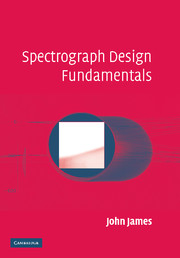Book contents
- Frontmatter
- Contents
- Preface
- Acknowledgements
- 1 A brief history of spectroscopy
- 2 The relevant regions of the electromagnetic spectrum
- 3 Geometrical optics
- 4 Optical aberrations
- 5 Fourier transforms: a brief revision
- 6 Physical optics and diffraction
- 7 The prism spectrograph
- 8 The plane grating spectrograph
- 9 The concave grating spectrograph
- 10 The interference spectrograph
- 11 The multiplex spectrometer
- 12 Detectors
- 13 Auxiliary optics
- 14 Optical design
- 15 Mechanical design and construction
- 16 Calibration
- 17 The alignment of a spectrograph
- Appendix 1 Optical aberrations
- Appendix 2 Wavelengths of spectral lines for calibration
- Appendix 3 The evolution of a Fabry–Perot interference spectrograph
- Appendix 4 The common calibration curve in silver halide spectrophotometry
- Bibliography
- Index
13 - Auxiliary optics
Published online by Cambridge University Press: 02 September 2009
- Frontmatter
- Contents
- Preface
- Acknowledgements
- 1 A brief history of spectroscopy
- 2 The relevant regions of the electromagnetic spectrum
- 3 Geometrical optics
- 4 Optical aberrations
- 5 Fourier transforms: a brief revision
- 6 Physical optics and diffraction
- 7 The prism spectrograph
- 8 The plane grating spectrograph
- 9 The concave grating spectrograph
- 10 The interference spectrograph
- 11 The multiplex spectrometer
- 12 Detectors
- 13 Auxiliary optics
- 14 Optical design
- 15 Mechanical design and construction
- 16 Calibration
- 17 The alignment of a spectrograph
- Appendix 1 Optical aberrations
- Appendix 2 Wavelengths of spectral lines for calibration
- Appendix 3 The evolution of a Fabry–Perot interference spectrograph
- Appendix 4 The common calibration curve in silver halide spectrophotometry
- Bibliography
- Index
Summary
Fore-optics
The correct use of a spectrograph requires that its aperture and its field be filled with light. More than this is not possible. Less than this is inefficient and may record the spectrum incompletely or incorrectly.
For most efficient use, the light source should be imaged on to the entry slit with a condensing lens, at a magnification which allows the whole slit length and width to be illuminated. The aperture of the condensing lens must be enough to allow the diverging light beam, after passing the slit, to fill the grating with light.
When this is done the condensing lens must itself be imaged on to the grating (not the collimator) by a relay lens somewhere near the entry slit, at a magnification sufficient to fill the grating with the image. If the condenser has been chosen properly in accordance with the first paragraph this will happen automatically. The aperture of the collimator must itself be large enough to avoid vignetting the grating, and the length of the entry slit and the distance of the collimator from the grating may well determine whether this is the case. The sort of fore-optical arrangement which meets these criteria is shown in Fig. 13.1.
However, there are perils in imaging a structured source on to the entry slit unless perhaps the source structure itself is being examined.
- Type
- Chapter
- Information
- Spectrograph Design Fundamentals , pp. 128 - 138Publisher: Cambridge University PressPrint publication year: 2007



